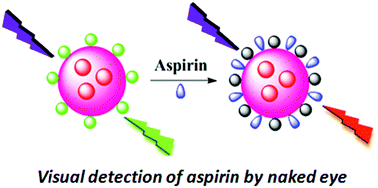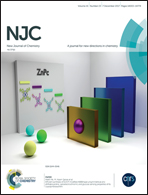Dual-emission ratiometric fluorescence detection of aspirin in human saliva: onsite naked-eye detection and high stability
Abstract
In this paper, a highly stable ratiometric fluorescence probe based on dual-emission quantum dots (QDs) was designed for the visual detection of aspirin. The probe was composed of two differently colored CdTe QDs, in which red-emitting QDs embedded in SiO2 (r-QDs@SiO2) acted as the reference signal and green-emitting QDs (g-QDs) covalently anchored on the surface of r-QDs@SiO2 served as the response signal. The fluorescence of r-QDs@SiO2 remained constant, whereas the fluorescence of g-QDs was quenched by the addition of aspirin. As a result, continuous color changes in the dual-emission fluorescence probe were observed. Under optimum conditions, the as-prepared dual-emission fluorescence probe was used for the determination of aspirin in a concentration range of 6.0–45 μmol L−1 with a detection limit of 0.20 μmol L−1. Furthermore, the present method was successfully applied in the detection of aspirin in real samples with a relatively high stability for about ten days.



 Please wait while we load your content...
Please wait while we load your content...